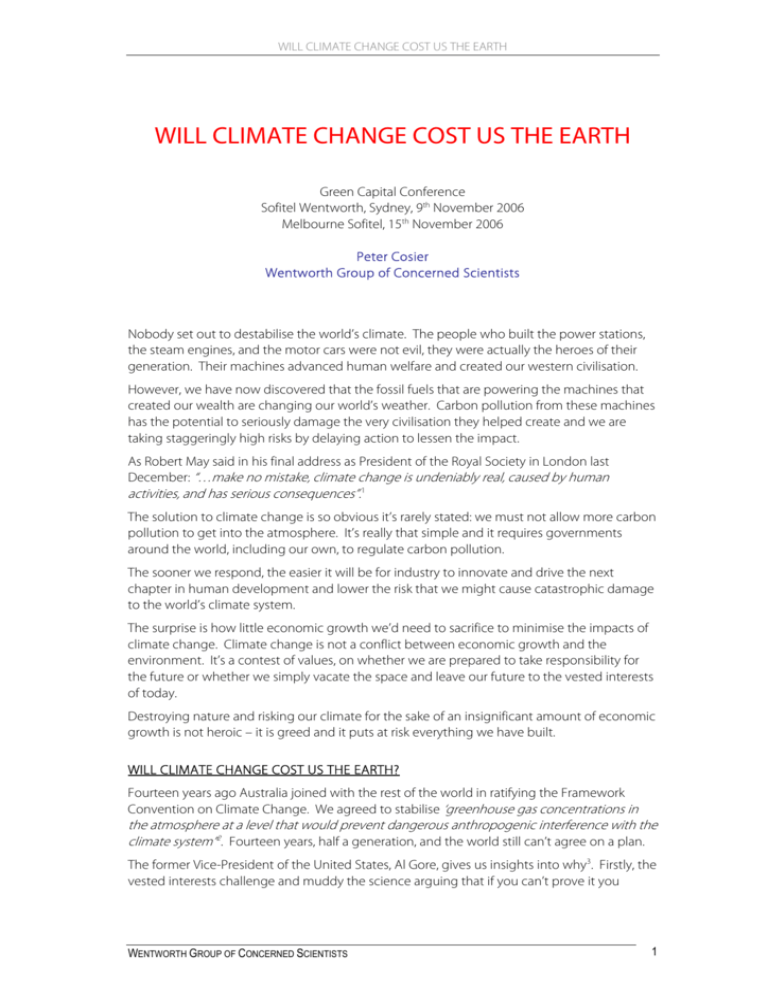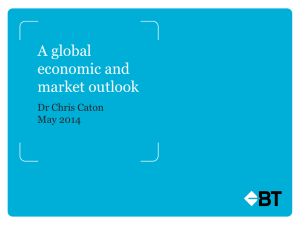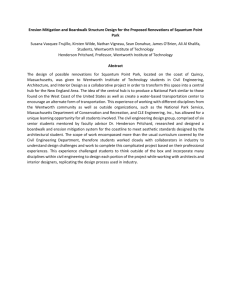will climate change cost us the earth
advertisement

WILL CLIMATE CHANGE COST US THE EARTH WILL CLIMATE CHANGE COST US THE EARTH Green Capital Conference Sofitel Wentworth, Sydney, 9th November 2006 Melbourne Sofitel, 15th November 2006 Peter Cosier Wentworth Group of Concerned Scientists Nobody set out to destabilise the world’s climate. The people who built the power stations, the steam engines, and the motor cars were not evil, they were actually the heroes of their generation. Their machines advanced human welfare and created our western civilisation. However, we have now discovered that the fossil fuels that are powering the machines that created our wealth are changing our world’s weather. Carbon pollution from these machines has the potential to seriously damage the very civilisation they helped create and we are taking staggeringly high risks by delaying action to lessen the impact. As Robert May said in his final address as President of the Royal Society in London last December: “…make no mistake, climate change is undeniably real, caused by human activities, and has serious consequences”.1 The solution to climate change is so obvious it’s rarely stated: we must not allow more carbon pollution to get into the atmosphere. It’s really that simple and it requires governments around the world, including our own, to regulate carbon pollution. The sooner we respond, the easier it will be for industry to innovate and drive the next chapter in human development and lower the risk that we might cause catastrophic damage to the world’s climate system. The surprise is how little economic growth we’d need to sacrifice to minimise the impacts of climate change. Climate change is not a conflict between economic growth and the environment. It’s a contest of values, on whether we are prepared to take responsibility for the future or whether we simply vacate the space and leave our future to the vested interests of today. Destroying nature and risking our climate for the sake of an insignificant amount of economic growth is not heroic – it is greed and it puts at risk everything we have built. WILL CLIMATE CHANGE COST US THE EARTH? Fourteen years ago Australia joined with the rest of the world in ratifying the Framework Convention on Climate Change. We agreed to stabilise ‘greenhouse gas concentrations in the atmosphere at a level that would prevent dangerous anthropogenic interference with the climate system”2. Fourteen years, half a generation, and the world still can’t agree on a plan. The former Vice-President of the United States, Al Gore, gives us insights into why3. Firstly, the vested interests challenge and muddy the science arguing that if you can’t prove it you WENTWORTH GROUP OF CONCERNED SCIENTISTS 1 WILL CLIMATE CHANGE COST US THE EARTH shouldn’t act. And finally, when the evidence becomes overwhelming, they frighten us into inaction by selective quoting of economic statistics to argue we can’t afford the cost. Their strategy works because they present the figures in a way that has us thinking we’ll either have to pay more tax or that the economy will fall into a recession and I’ll lose my job and the house, knowing all the time that these are future costs which will be balanced against future economic growth. It works because most people are already geared to capacity – mortgages, car payments, school fees. The last thing they need is a new tax or a recession. Look at the public and political reaction recently when interest rates went up 0.25 per cent. We all know how this works. The tactics of the oil and coal lobby mimic the old tobacco and asbestos industries. It buys time, and time is money. They push our democracy and Australian fair-mindedness to the limits. The longer and harder they push, the more profits they make. This is no game, they are playing with the future of Australia and our world. Enter ABARE - the Australian government’s key source of economic advice on climate change. They recently released a report titled “Economic Impact of Climate Change Policy”4. This is part of what the ABARE press release of the 17th July said: “One scenario explores the possibility of Australia reducing its emissions by 50 per cent below 1990 levels by 2050. In this case Australia’s GDP is projected to be 10.7 per cent lower than it would otherwise have been in 2050. Output from key energy intensive industries is projected to fall between 50 and 75 per cent and the agricultural sector would also experience a 44 per cent decline in output relative to what would otherwise have occurred at 2050” 10.7% lower GDP – it sounds like the next Great Depression! Australians deserve better than this from a government agency. Their own data show that if we spread the cost of reducing global carbon pollution over the next two generations, the economic cost, even using the one sided ABARE assumptions, will be infinitesimally small. HEROES OF THE INDUSTRIAL REVOLUTION How is it possible to have such extreme interpretations from the same statistics? To fully appreciate the significance of this, I need to take you right back to how western civilisation got to where we are today. Stay with me, it’s important. And no, it’s not a gloom and doom story. Far from it, it’s a story of heroic proportions, because it was the industrial revolution that built the machines that liberated humanity. Because of machines we have more choices and more opportunity than any generation in history. They have given us health care, fast cars, shops full of food, schools, the 40 hour week, 4 weeks annual leave, sick leave, television, the internet, coffee shops, dress shops, … the list goes on. They freed us from subsistence and lifted us above nature. The following graph shows the economic history of western civilisation. It’s based on work of OECD economist Angus Maddison5. WENTWORTH GROUP OF CONCERNED SCIENTISTS 2 WILL CLIMATE CHANGE COST US THE EARTH Economic Growth in Western Economies including Australia, Great Britain, United States, France, Germany, Canada 1AD to 2005AD $35,000 Per Capita GDP in 2005 Australian Dollars $30,000 $25,000 $20,000 $15,000 Beginning of the Industrial Revolution $10,000 Motor Cars Power Stations When Jesus was a baby Steam Engines $5,000 $0 0 200 400 600 800 1000 1200 1400 1600 1800 2000 Year WENTWORTH GROUP OF CONCERNED SCIENTISTS It is a profoundly important graph because not only does it show the explosion of wealth in western economies since the industrial Australian Economic Growth revolution, it also provides the 1800AD to 2005AD pathway for us to address our longterm environmental problems as well. Today I’ll get to that in a moment. $44,100 $45,000 $40,000 Just look at the explosion in our wealth since the invention of the machines. $35,000 By the time Australia became a nation in 1901, average incomes had reached $6,000 in today’s money. But even that was just the beginning. Today our average income in this country is over $44,000 for every man, woman and child. $30,000 $25,000 Oil Crisis $20,000 World War II We are eight times more wealthy than our grandparents and we live in a world beyond their wildest imagination. All because of machines. This second graph shows the explosion of wealth in Australia since the industrial revolution and how the machines powered over all the great setbacks – drought, two world wars, the great depression. WENTWORTH GROUP OF CONCERNED SCIENTISTS The Great Depression Per Capita GDP in 2005 Australian Dollars The recession we had to have $15,000 World War I 1890s Drought $10,000 $5,000 $0 1800 1850 WENTWORTH GROUP 1900 1950 2000 Year OF CONCERNED SCIENTISTS 3 WILL CLIMATE CHANGE COST US THE EARTH Just look at the economic growth since World War II. You can hardly see the so-called ‘oil crisis’ of the 1970s. The western world has embraced the capitalist model as the vehicle for human advancement with spectacular success. We are without doubt, the wealthiest generation in history. THE CHALLENGE OF OUR GENERATION But we have a problem. Each year we burn 1 million years of pre-historic plant growth in the form of fossil fuel and release it into our atmosphere6 and it in turn is causing carbon pollution which is heating up our planet. There is no way for us to predict conclusively what global warming will do to our world, but we do know that we are now in un-chartered territory. One look at the NASA climate charts7 and you know we have a problem. The earth’s climate may respond dramatically and unexpectedly and we are not prepared. What vested interests have managed to do by contesting the science is buy themselves time. But as this is now showing signs of failing, they’ve moved to Plan B, positioning the debate as a choice between the environment and the economy. The 2002 Intergenerational Report prepared by the Australian Treasury8, predicts that short of any unexpected shocks, per capita growth will continue between now and 2050, at between 1.5 and 2.1 per cent of GDP per annum. If the lower rate of 1.5 per cent per annum is projected over the following 50 years, at the end of this century living Australian Economic Growth standards in Australia will rise from 1800AD to 2100AD $44,000 per person to over $185,000 per person. And we know that Treasury projections are conservative: 2100 average per capita economic growth in $185,000 to $176,700 Australia in the past 50 years averaged 2.7 per cent. $200,000 $180,000 $160,000 $120,000 2050 $87,900 to $85,300 $80,000 2005 $44,100 But here’s the key – our behaviour today is putting all this at risk and for what? We’re putting it all at risk because we believe its wealth or the environment. This is absolute nonsense – and here’s why. The blue line is projected economic growth based on the Treasury projections. WENTWORTH GROUP OF CONCERNED SCIENTISTS $100,000 Per Capita GDP in 2005 Australian Dollars $140,000 That’s right, by 2100, over $185,000 for every man, woman and child, in today’s dollars. These are unimaginable figures, just as it would be unimaginable for our grandparents in 1901 to begin to conceive the world they were creating for us today. $60,000 1945 $10,200 $40,000 1900 $5,900 $20,000 $0 1800 1850 WENTWORTH GROUP 1900 1950 2000 2050 2100 Year OF CONCERNED SCIENTISTS 4 WILL CLIMATE CHANGE COST US THE EARTH The red line is based on the best available international modelling of the economic impact of deep cuts in global emissions, involving high income countries reducing their greenhouse footprint by at least 60% by 2050910. It describes the impact of a 4.5 per cent cut in per capita GDP in Australia by 2100, as a result of these deep emission cuts. This figure assumes that the economic impact on Australia is around three times the average impact for the world as a whole. It has to, because you couldn’t see the difference otherwise. This involves a massive change in future emissions, but it is the scale of action that is required if we are to limit CO2e to less than 450 parts per million – a level the climate scientists advise is needed to limit global temperature rise to 2 degrees. Just compare the extrapolated economic growth projections from our Treasury and how it would differ if the world stabilised CO2 emissions. Not a lot of difference is there? We can have an annual income in today dollars of $185,000 and risk everything, or an annual income of $177,000 and help stabilise the world’s climate. Last week the former chief economist to the World Bank, Nicholas Stern, released his long awaited report ‘The Economics of Climate Change’11. This report compares the economic costs of doing nothing with the economic costs of fixing the problem. This contrasts with most economic modelling, including the ABARE report, which only look at the impacts of reducing emissions and ignore the benefits of doing so. Looking at both sides of the balance sheet, Stern finds that the impact of doing nothing is at least ten times more than the cost of fixing the problem. Which ever model you accept, this graph presents us with a very powerful moral choice, and the choice we make today will dictate the future of our civilisation for all time. WE MAY NOT BE SO LUCKY NEXT TIME History tells us that not only has the industrial revolution lifted humanity above nature, it also demonstrates that humanity can respond to an environmental crisis when it accepts that we have one. Our quick and decisive global response to ozone eating CFCs is an example. In the mid 1980s the world was awoken by scientists to the rapid loss of the atmospheric ozone layer and the creation of the ozone hole over Antarctica. The cause was Chlorinated Flurocarbons (CFCs). Few people realised at the time just how close our civilisation came to causing a global catastrophe. As Tim Flannery points out is his book ‘The Weather Makers’12, chlorine is a very similar element to another atom called bromine. Chlorine and bromine can be used interchangeably for many purposes. The reason chlorine was used to produce CFCs rather than bromine to produce BFCs, is simply because chlorine is cheaper to produce. BFCs would have done just as good a job. However, and here’s the twist, it turns out that bromine is forty five times more destructive to ozone than chlorine. Had bromine been used or had chlorine reacted with ozone like bromine does, it would have torn apart the ozone layer before the Nobel winning scientists had even discovered the cause of the problem. In a matter of decades, skin cancers would have spread across the world and the marine and terrestrial ecosystems we depend upon would have been severely damaged to the point that our civilisation would have been under intolerable stress. The message of this story is don’t play around with the world’s life’s support systems. If science is warning we may have a problem, we’d better listen, because delaying action could cost us the earth. There may be no second chance this time. WENTWORTH GROUP OF CONCERNED SCIENTISTS 5 WILL CLIMATE CHANGE COST US THE EARTH WE ARE RESPONSIBLE FOR OUR FUTURE Nobody set out to destabilise the world’s climate, just as nobody set out to pollute our atmosphere with CFCs. Both were seen as great noble causes because they advanced human welfare, but it turns out that both have the potential to seriously damage our civilisation. The great challenge for our parent’s and grandparent’s generations was to build a new society out of the ashes of the Great Depression and two horrific World Wars. They were spectacularly successful. Destroying nature and risking our climate for the sake of an infinitesimally small change in economic growth is not heroic – it is greed and it puts at risk everything we have built. Today our great challenge is to save this world from ourselves. *** Footnote: The estimated impact of policy action presented in this paper is based on the results from eleven international models, reported by Grubb et al 2006. Nine of the eleven models indicate emission reductions are likely to result a GDP gap -1% or less relative to levels without emissions reductions by 2050. A number of models indicate no impact (a zero GDP gap), and two suggest economic gains, reflected in higher rates of economic growth with emission reductions, due to factors such as enhanced productivity from more rapid turnover of energy-related physical capital. Results from these nine models are more dispersed in the second half of the century, with GDP gaps ranging from +3.5 to -3.0 percent, with most between 0 and -1%. The estimate presented assumes the GDP gap rises to -1.5 by 2100. The impact on Australia is assumed to be three time the world average, implying a GDP of -3% by 2050, rising to -4.5% by 2100. This ratio is more conservative than the impact ratios suggested by ABARE (2006), which generally indicates impacts on Australia that are around twice the average world impact. The Stern Report finds that temperature increases are likely to have non-linear impacts on living standards, with increases on 2oC above pre-industrial levels reducing per capita economic income by around 1.5%, and increases of 4oC reducing incomes by around 6%. Applying these estimates to Australia suggests GDP per capita with policy action with be higher than without action from around 2080 – if we assume Australian policy action is three times more costly than the world average. If we assume policy action is 1.5 times as costly, policy action results in higher incomes from 2055. ACKNOWLEDGEMENT This paper was prepared with advice from Dr Steve Hatfield Dodds, CSIRO Economist and President of the Australian Society of Ecological Economics. REFERENCES 1 Sir Robert May, 2005. Annual Anniversary Address, Royal Society, December 2005 www.royalsoc.ac.uk UNFCCC, 1992. United Nations Framework Convention on Climate Change, Rio de Janero, June1992. www.unfccc.int 3 Al Gore, 2006. An Inconvenient Truth Bloomsbury Publishing Plc. London 4 ABARE, 2006. Economic Impact of Climate Change Policy: the role of technology and economic instruments www.abareconomics.com/publications 5 Angus Maddison, 2003. The World Economy: Historical Statistics OECD 6 Dr Simon Lewis, 2006. Climate Change, Royal Society Research Fellow. www.royalsoc.ac.uk 7 NASA Goddard Institute for Space Studies, 2006. In Technology Review, July/August 2006 edition 8 Australian Treasury, 2002. Intergenerational Report 2002-03 Budget Paper No.5, May 2002 9 Ahammad, H., A. Matysek, B.S. Fisher, R. Curtottie, A. Gurney, G. Jakeman, E. heyhoe and D. Gunasekera, 2006. Economic impact of climate change policy: The role of technology and economic instruments, ABARE Research Report 06.7, ABARE, Canberra 10 Grubb, M., C. Carraro, J. Schellnhuber, 2006. ‘Technological Change for Atmospheric Stabilisation: Introductory Overview to the Innovation Modelling Comparison project’, Energy Journal (Special Edition: Endogenous Technological change and the Economics of Atmospheric Stabilization) pp.1-16 11 Stern, 2006: Stern Review: The Economic of Climate Change. www.hmtreasury.gov.uk/independent_reviews/stern_review_economics_climate_change 12 Prof Tim Flannery, 2005. The Weather Makers Text Publishing, Melbourne 2 WENTWORTH GROUP OF CONCERNED SCIENTISTS 6







